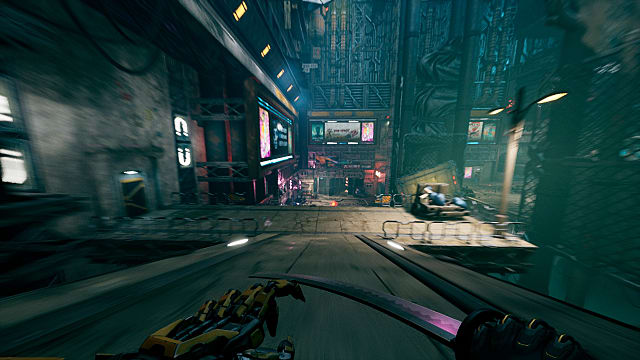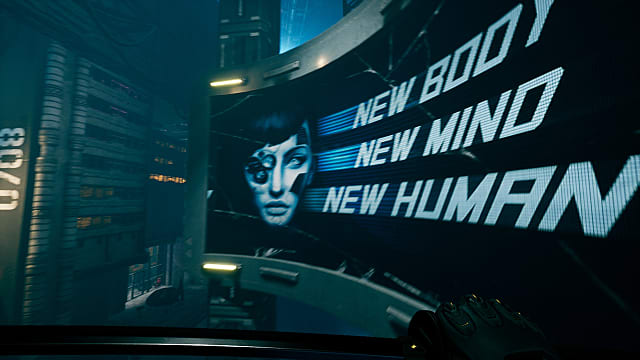It’s a game in the vein of fast-paced hack-and-slash fair like Katana Zero, but instead of high-quality pixel art, players experience some of the highest-fidelity graphics possible on modern hardware, at framerates even most AAA games dream of.
But how does it play? Is it worth your time? Let’s take a look.
GhostRunner: One-Hit Kill
Sure, you are a machine of death in GhostRunner, but it only takes one hit to kill you. Thankfully, your enemies are just as fragile.
Problem is, they have guns, and all you have is a razor-sharp blade and expensive cybernetics.
The game gets around this problem by combining two classic mechanics: bullet time and air dashing. Enemy projectiles have a travel time, but if your reactions are fast enough, you can enter bullet time to dodge them in mid-air.
When you exit bullet-time, you’ll dash towards the enemy. Hopefully, it’s without eating a bullet for your trouble.
Should you fail, though, GhostRunner has a robust set of checkpoints set up before each challenge arena, and you load into them instantly after dying. I was playing the game’s Steam demo on an M.2 SSD, and there was no loading time between death and respawn. Slower hard drives might need a second or two.
That might be a blessing in disguise, as GhostRunner’s pace will set your heart to overdrive.
Given that the demo is only about 10 minutes long, even with plenty of failures, difficulty ramps up quickly, and the introduction of new mechanics comes fast and furious. You’ll learn how to climb, wall run, slide, and kill in a matter of moments.
From there, you’ll learn how to enable and work within bullet-time, and then you’ll combine everything you’ve learned into a singular methodology to use in more and more demanding arenas. The last thing you’ll learn is a grapple, which gets put to use immediately.
Chaining abilities is as satisfying as you might hope in a game such as this, and it should be. Failures can be frustrating, especially because the game’s enemies are incredibly accurate, and your margin for error so small.
Don’t let that dissuade you from trying the demo out, though. GhostRunner is not a forgiving game, but it rewards successful kills and flawless parkour. It’s well worth the price of admission.
Wall-Running Like a Dream
GhostRunner, even in its demo state, shows the power of Unreal Engine 4, and it runs better than I would have ever hoped. Even with everything on maximum and RTX turned on, I was easily breaking 60fps at 1080p. The game’s recommended specs aren’t demanding either, so while a top of the line rig can push this game’s limits, even mid-tier and budget-builds should be able to have a good time.
There are plenty of customizable settings too, and the developers have even gone so far as to push an update to the demo, adding more options, including an FOV slider and fully-unlockable FPS. It’s clearly a game built for PC first and foremost.
While something like this is playable on a controller, the sheer speed of the gameplay on offer is probably best experienced with the freedom of movement a mouse and keyboard provide.
More importantly, the game looks amazing. I would go so far as to compare it to Cyberpunk 2077 at times, both in terms of fidelity and the quality of its art style. Everything looks and feels like a badass dystopian future, from the propaganda to the cybernetics, animations, and environments.
Whispers in Your Head
The story of a game like GhostRunner only really exists to string together the various gameplay challenges, and we don’t get much of it in the short Steam demo.
What we do have is pretty standard cyberpunk fair. Something about a prisoner with tech abilities that needs rescuing, the player character having messy cybernetics, and the usual corporate overlords in control of more than you’d ever realize.
All that doesn’t mean the story will be bad, and the final scene has me itching to know more. There’s definitely more underneath the surface, and nothing is ever as it seems, but if GhostRunner wants to capture audiences with its narrative, it needs to follow Katana Zero’s example.
In other words, it needs to have interesting characters and story-gameplay integration. I see shades of that already in the demo, and the environments show directions a story could go. I’m excited either way.
I’m intrigued enough by GhostRunner to put it on my excited-for list, and you should keep it on your radar as well. Even if it’s not your kind of game, it is one that shows what’s possible on the latest tech.



